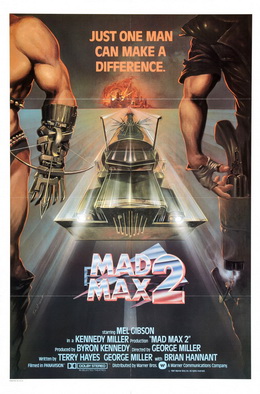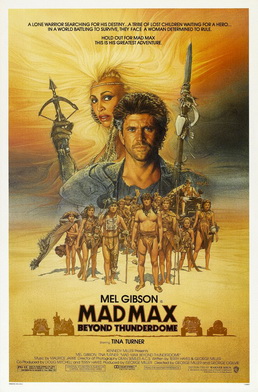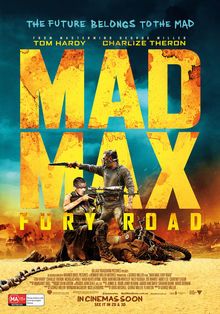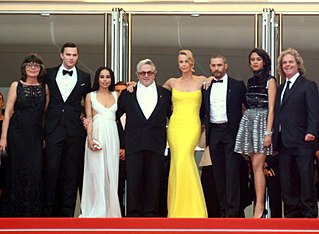Related Research Articles

George Miller is an Australian filmmaker, best known for his Mad Max franchise, whose second installment, Mad Max 2, and fourth, Fury Road, have been hailed two of the greatest action films of all time, Fury Road winning six Academy Awards. Miller is very diverse in genre and style as he also directed the biographical medical drama Lorenzo's Oil, the dark fantasy The Witches of Eastwick, and the Academy Award-winning animated film Happy Feet, produced the family-friendly fantasy adventure Babe and directed the sequel Babe: Pig in the City.

Mad Max 2 is a 1981 Australian post-apocalyptic dystopian action film directed by George Miller, who co-wrote it with Terry Hayes and Brian Hannant. It is the second installment in the Mad Max franchise. The film stars Mel Gibson reprising his role as "Mad Max" Rockatansky and follows a hardened man who helps a community of settlers to defend themselves against a roving band of marauders.

Mad Max Beyond Thunderdome, commonly known as Mad Max 3, is a 1985 Australian post-apocalyptic dystopian action film directed by George Miller and George Ogilvie and written by Terry Hayes and Miller. It is the third installment in the Mad Max franchise. The film stars Mel Gibson and Tina Turner, and follows a lone roving warrior who is exiled into the desert. It was Gibson's last role as "Mad Max" Rockatansky.
Mad Max is an Australian media franchise.

"Addicted to Bass" is a song by Josh Abrahams (Puretone) and Amiel Daemion, featuring Daemion on vocals. It reached the top 20 in the Australian charts in 1998. It originally appeared on Abrahams' 1998 album, Sweet Distorted Holiday, and was included on the 2002 album Stuck in a Groove—credited to Abrahams' alias Puretone. The original release reached number 15 in Australia and number 27 in New Zealand while a 2002 remix by Apollo 440 reached number two on the UK Singles Chart and number one on the US Dance Club Songs charts.

Kenshiro is a fictional character and the protagonist of the Fist of the North Star manga series created by Tetsuo Hara and Buronson. In the story, Kenshiro is the rightful successor of an ancient art of assassination called Hokuto Shinken, which allows him to defeat his adversaries through the hidden meridian points.

The Pursuit Special, also referred to as the Last of the V8 Interceptors, is the iconic black GT Falcon muscle car featuring a distinctive supercharger driven by the title character Mad Max during much of the Mad Max franchise, where it appears in Mad Max, Mad Max 2: The Road Warrior and in Mad Max: Fury Road, as well as both video games.

Max Rockatansky is the title character and antihero protagonist of the Australian post-apocalyptic action film series Mad Max. Created by director George Miller and producer Byron Kennedy, the character was originally played by actor Mel Gibson in the first three films from 1979 to 1985, and later Tom Hardy in the fourth in 2015.

Hugh Keays-Byrne was a British-Australian actor. Between 1968 and 1972 he was a member of the Royal Shakespeare Company. He played the antagonist in two films from the Mad Max franchise: Toecutter in Mad Max, and Immortan Joe in Mad Max: Fury Road.

Mad Max is a media franchise created by George Miller and Byron Kennedy. It centers on a series of post-apocalyptic and dystopian action films. The franchise began in 1979 with Mad Max, and was followed by three sequels: Mad Max 2, Mad Max Beyond Thunderdome (1985) and Mad Max: Fury Road (2015); Miller directed or co-directed all four films. Mel Gibson portrayed the titular character Max Rockatansky in the first three films, while Tom Hardy portrayed the character in Mad Max: Fury Road.
Kennedy Miller Mitchell is an Australian film, television and video game production house in Potts Point, Sydney, that has been producing television and film since 1978. It is responsible for some of Australia's best-known and most successful films, including the four Mad Max films, the two Babe films, and the two Happy Feet films.

Mad Max: Fury Road is a 2015 Australian post-apocalyptic action film co-written, co-produced, and directed by George Miller. Miller collaborated with Brendan McCarthy and Nico Lathouris on the screenplay. The fourth instalment in the Mad Max franchise, it was produced by Village Roadshow Pictures, RatPac-Dune Entertainment and Kennedy Miller Mitchell, and distributed by Roadshow Entertainment in Australia and by Warner Bros. Pictures internationally. The film stars Tom Hardy and Charlize Theron, with Nicholas Hoult, Hugh Keays-Byrne, Rosie Huntington-Whiteley, Riley Keough, Zoë Kravitz, Abbey Lee, and Courtney Eaton in supporting roles. Set in a post-apocalyptic desert wasteland where petrol and water are scarce commodities, Fury Road follows Max Rockatansky (Hardy), who joins forces with Imperator Furiosa (Theron) against cult leader Immortan Joe (Keays-Byrne) and his army, leading to a lengthy road battle.

Mad Max is an action-adventure video game based on the Mad Max franchise. Developed by Avalanche Studios and published by Warner Bros. Interactive Entertainment, it was released for PlayStation 4, Windows, and Xbox One in 2015. Feral Interactive published the game's Linux and macOS versions. In the game, players control Max Rockatansky as he progresses through the wasteland building a vehicle, the "Magnum Opus", to do battle with a gang of raiders, led by Scabrous Scrotus, and to reach the storied "Plains of Silence", where he hopes to find peace. Mad Max emphasizes vehicular combat, in which players can use weapon and armor upgrades on their car to fight enemies. It is set in an open post-apocalyptic wasteland consisting of deserts, canyons, and caves.

Doug Mitchell is a film producer.

Mad Max: Fury Road is a limited comic book series created by George Miller, Nico Lathouris and Mark Sexton. Serving as a prequel to the 2015 film of the same name, in addition to bridging the events of the film with the 1985 film Mad Max Beyond Thunderdome, the series focuses on several characters from the film at various points in their lives before it.
Lesley Vanderwalt is a New Zealand cinematic hair designer and makeup artist. Vanderwalt was raised and began her career in New Zealand before moving to Australia. She has frequently collaborated with directors such as George Miller and Baz Luhrmann.

Wasteland Weekend is an annual festival held in Edwards, California. The event is listed as a full immersion event, with all participants required to adhere to the set theme. It has been held annually in September since 2010, except for 2020, when the event was cancelled due to the COVID-19 pandemic. In 2019, the 10th-anniversary edition of Wasteland Weekend was held from September 25 to September 29.
"Rickmancing the Stone" is the second episode of the third season of the American science fiction television series Rick and Morty. Released on July 30, 2017, it follows main characters Rick Sanchez and Morty Smith as they enter a post-apocalyptic world to find the gemstone by the name of Isotope 322, also bringing Morty's sister Summer with them. The episode was written by Jane Becker and director by Dominic Polcino. The title is a reference to the 1984 film Romancing the Stone with Michael Douglas.
Rick and Morty is an American animated science-fiction comedy franchise, whose eponymous duo consists of Rick Sanchez and Morty Smith. Rick and Morty were created by cartoonist Justin Roiland for a 2006 parody film of Back to the Future for Channel 101, a short film festival co-founded by Dan Harmon. After six years, the sketch was developed into Rick and Morty, a half-hour prime time show that was a hit for Adult Swim, receiving universal acclaim across all seasons. Alongside the original television series, the characters of the show have been featured in a variety of media, including spin-offs, comic books, musical releases and video games. The show has earned hundreds of millions of dollars in income across their merchandising and media franchise.
References
- 1 2 Barra, Allen (15 August 1999). "FILM; A Road Warrior Is Still on a Roll". The New York Times . p. 2. Archived from the original on 17 May 2015. Retrieved 17 May 2015.
- ↑ Hartman, Matthew (14 May 2015). "Maximized Entertainment: A Look At the Legacy of George Miller's Mad Max". High-Def Digest. Internet Brands. Archived from the original on 18 May 2015. Retrieved 18 May 2015.
- ↑ Wade, Chris (14 May 2014). "How Mad Max Revolutionized What the Future Looked Like in Film". www.vulture.com.
- ↑ Robinson, Joanna (15 May 2015). "8 Reasons Why Mad Max Is the Most Improbable Franchise of All Time". Vanity Fair .
the legacy of Mad Max stretches all the way back to the original 1979 film, which kicked off an improbable franchise with an even bigger mark on pop culture than you might think. ... famed filmmakers from David Fincher to Guillermo del Toro to James Cameron all cite the enormous influence of Max Rockatansky and his creator-director George Miller.
- ↑ Lewis, Maria (8 October 2020). "Mad Max's enduring pop culture power". Australian Centre for the Moving Image.
- ↑ Byrnes, Paul. "Mad Max (1979): Curator's notes"". National Film and Sound Archive.
The influence of Mad Max would be hard to overstate. Some would say it is the most influential movie ever made in Australia. The film had a profound effect on filmmakers and audiences around the world.
- ↑ "Interview with Buronson". ADV Films Presents: New Fist of the North Star. Archived from the original on 2007-02-18. Retrieved 2007-07-21.
- ↑ McDonough, Maitland. "Not Quite Hollywood: the Wild, Untold Story of Ozploitation!". Film Journal International. Vol. 112, no. 8., Aug. 2009. p.73
- ↑ "Mad Max References Puretone - Addicted To Bass" . Retrieved 10 January 2014.
- ↑ O'Donnell, Kevin (11 February 2011). "Ke$ha Talks U.$. Tour: "It's an Epic Dance Party"". Spin. Retrieved 11 February 2011.
- ↑ "Fallout: New Vegas designer Josh Sawyer on post-apocalyptic games". The Guardian. 10 November 2010.
- ↑ "Five Favorite Films With Guillermo Del Toro". Rotten Tomatoes .
- ↑ "David Fincher's Favorite Movies of all Time". 29 October 2008.
- ↑ "The Reformation of a Rebel Without a Crew". Archived from the original on 2011-01-05.
- ↑ "Zack Snyder's Favorite Films, from "A Clockwork Orange" to "Blue Velvet"". 15 November 2017.
- ↑ "[鳥山明ほぼ全仕事] 平日更新24時間限定公開! 2020/06/12". Dragon Ball Official Site (in Japanese). Shueisha. 12 June 2020. Archived from the original on 12 June 2020. Retrieved 11 December 2021.
- ↑ Tarrant, Shira; Jolles, Marjorie (29 August 2012). Fashion Talks. ISBN 9781438443218.
- ↑ "Looking back at Waterworld: overlooked or under water?". Den of Geek. 16 December 2014.
- ↑ Pareles, Jon (2 November 1986). "HOME VIDEO; Recent Releases Of Video Cassettes: Photos and 'White Suit'". The New York Times . Archived from the original on 12 October 2014. Retrieved 17 May 2015.
- ↑ "Roaming The Wasteland: 5 Video Games Inspired By 'Mad Max'". Tech Times. 6 May 2015.
- ↑ "Everything's Gone 8-Bit!". Everything's Gone 8-Bit!. Retrieved 2019-08-07.
- ↑ "Exclusive: A Look At Brendan McCarthy And Grant Morrison's Long Lost Movie Pitch, Shatterland". Bleeding Cool News And Rumors. 2013-08-30. Retrieved 2019-08-07.
- ↑ "Welcome to the official W.A.S.P. Nation website". waspnation.com. Archived from the original on 2011-12-01.
- ↑ Reeve, Philip. "Philip Reeve Twitter". Archived from the original on 18 May 2015. Retrieved 18 May 2015– via Twitter.[ non-primary source needed ]
- ↑ "My Chemical Romance's 'Na Na Na' Video: A Pop-Culture Cheat Sheet". MTV .
- ↑ Venable, Nick (1 February 2014). "The Voice Channels Mad Max With New Trailer". CinemaBlend.com.
- ↑ Wilson, Elliott (April 2005). "XXL". Pop Shots. Harris Publications. pp. 131–135.
- ↑ Chin, Mike (31 October 2008). "The Importance of…10.31.08: The Importance of the Spin the Wheel, Make the Deal Match". 411mania.com.
- 1 2 "'Rick and Morty' Episode 2 Will Feature BDSM Apocalypse Warriors". Inverse. 23 July 2017.
- ↑ Sullivan, Kevin P. (13 July 2017). "What Dunkirk owes to Mad Max: Fury Road". Entertainment Weekly .